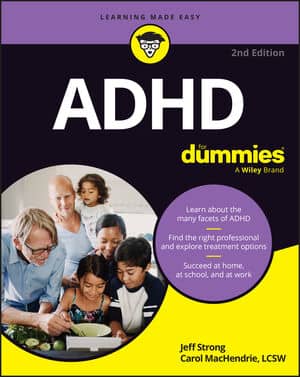The psychological disorder ADHD used to be called ADD or Attention Deficit Disorder, but it’s been officially recognized as ADHD for at least 20 years. The actual diagnostic symptoms of ADHD are divided into two categories: symptoms of hyperactivity and impulsivity and symptoms of inattention.
Individuals can display predominant symptoms in one of the two categories and meet criteria for the diagnosis. Or, they can have symptoms in both and be considered a “combined type.” Here’s rundown of the symptoms associated in each of the two categories:
Hyperactivity and impulsivity: Fidgety, squirmy, can’t stay seated, runs and climbs excessively, can’t play quietly, always on the go, talkative, can’t wait, interrupts, and is intrusive
Inattention: Difficulties with paying close attention to details, making careless mistakes, difficulty sustaining attention, not appearing to listen, poor follow-through and finishing things, loses things, is distractible, and forgetful
ADHD can range in severity from very mild to severe and is not typically diagnosed before the age of 4 years old. Boys are more likely to have ADHD, but it shows up in girls, too. The most common treatment is medication, typically in the class of psychostimulants (such as Ritalin or Straterra), but behavior modification and psychosocial interventions are also important parts of treatment.
Specifically, the approach popularized by Russell Barkley and in the work of Dr. Arthur D Anastopoulos uses psychosocial interventions that include behavior modification components, parent education, child education, and counseling, if necessary.
Wait a minute, did that say “psychostimulants”? That’s right, the medication used to treat ADHD functions as a brain stimulant. It’s the concept of adults using coffee to stay up and work or study. People tend to concentrate a little better when they’re a little wired.
Although it seems counterintuitive, the underlying neuropsychological deficits of ADHD are consistent with the use of a stimulant medication. Essentially, the symptoms of ADHD are the result of the less-than-optimal functioning of the frontal lobe of the brain, deficits in its functions known as executive functions, such as planning and organizing.
The frontal lobe and its executive functions play a critical role in inhibition and impulse control, organization, attention, concentration, and goal-directed behavior, which is knowing how to stay on target to meet a goal, even if that goal is simply picking up your socks.
For people with ADHD, the frontal lobe is “underpowered” and not up to its tasks, thus leaving the rest of the brain disorganized, impulsive, overly active, and prone to a bit of wandering. Stimulant medications address the power shortage, give the frontal lobe a boost, and slow down Joe ADHD to focus him and increase his impulse control.
The cause of this frontal lobe power deficit has yet to be fully identified but research shows a strong genetic component and the role of some sort of negative developmental event or exposure that results in underdevelopment of the frontal lobe and executive functions.

